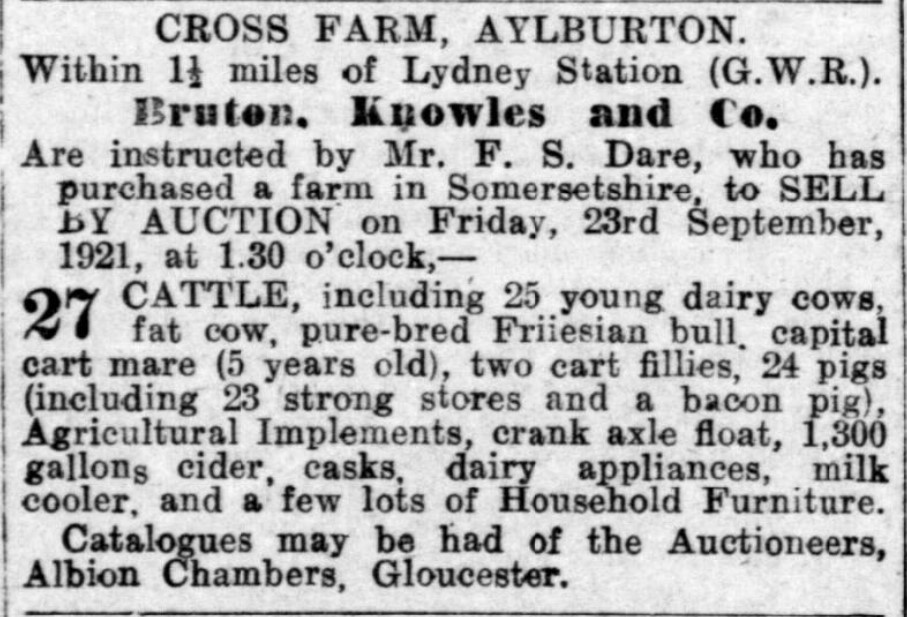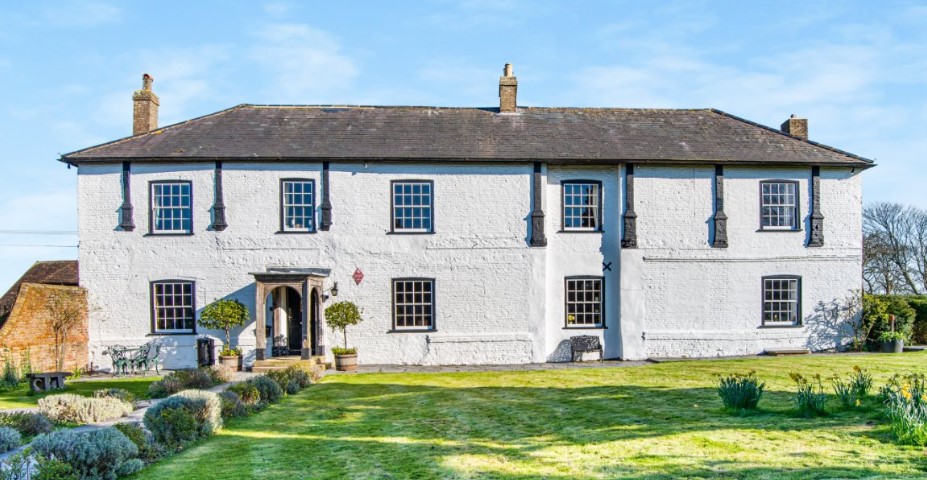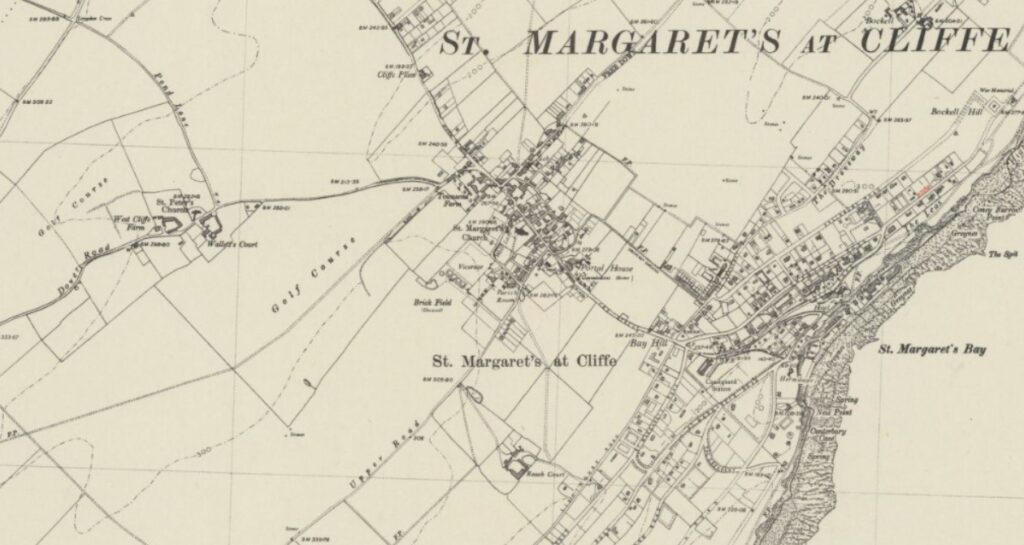Introduction
This article examines the life of Frederick Samuel Dare, who farmed at Kingswood Farm, Hardington, from 1921 to 1934. It places his life within the context of his family’s history, beginning with his paternal grandfather and continuing with his father. The research that forms the basis of this article was guided by three questions:
(a) Was Frederick’s father a “gentleman”? (The marriage records for three of his children—Henry, Margaret, and Leonard—identify his occupation as “Gentleman.”)
(b) What circumstances led Frederick to become a farmer?
(c) What became of Frederick after he left Hardington?
Isaac Dare (Frederick’s paternal grandfather)
Frederick’s paternal grandfather, Isaac Dare, was born at Chardstock in about 1792. He married Joan Smith on 20 April 1824 at Whitchurch Canonicorum; at the time, Isaac was about 32 years old, while Joan was about 24.
Isaac was a tenant farmer who occupied various farms across Devon, Dorset and Somerset. By June 1841, the family lived at Ubley Hill Farm, Ubley, a parish in the Mendip Hills.[1] At that time, seven children lived at home, while the eldest daughter, Jane, worked as a servant for a local clergyman. Two more children were born within the next three years.
In 1849, Isaac fell ill with tuberculosis. He made his will on 10 August, leaving all his real and personal property to his wife, and he passed away on 29 August.[2]
After his death, his widow and children returned to his home parish of Chardstock, settling at Honeyhill Cottage. By March 1851, five children still lived at home, including her eldest son, Robert, who worked as a farm labourer.
Isaac’s death had transformed the family’s circumstances, and they must have gone through a period of painful adjustment. His son, Robert, aspired to elevate his social position but ultimately failed. However, his grandson, Frederick, achieved remarkable success.
Robert Dare (Frederick’s father)
In his twenties, Robert moved to London, where he found work as a waiter. There, he met Sarah Elizabeth Dunn, the daughter of a Northampton cabinet maker. The couple married at St Giles, Northampton, on 3 January 1871. At the time of their marriage, Robert was 45 and Sarah was 23. Both signed the marriage register.
According to the marriage register, Robert was a bachelor; however, the 1861 census recorded him as married. If he had been married previously, it could explain his age, but details about his first wife remain unknown.
Just before marrying, Robert had become the landlord of the Tytherleigh Arms Inn, Chardstock, taking over from Patience Follett (nee Dare), who may have been a distant relative. He remained there until 1875 when he became the tenant of the White Horse Inn at Ilminster.[3]
During his time at Chardstock, Robert organised various events to promote the inn’s business. In July 1871, he hosted a picnic for seventy people in a marquee, followed by dancing in the evening. During the subsequent winter, he also held a series of public readings at the inn.[4]
In May 1873, he may have faced a rude awakening when acting as his mother’s sole executor. She had left him her freehold cottage and land at Honeyhill, Chardstock, but this was subject to his paying the principal sum of £40, any arrears of interest on the mortgage and legacies of £25 each to two sisters. Since his mother’s estate was valued at “under £20,” nothing remained for Robert.[5]
By 1885, Robert was heavily in debt and attempted to escape his creditors by taking on the tenancy of the Queens Arms Hotel, Bleadon, near Axbridge.[6] However, his debts caught up with him. In 1886, he went bankrupt and was forced to sell his stock and effects at Ilminster and his freehold and copyhold property at Chardstock. Instead of providing proper accounts for the previous three years, as the law required, he submitted estimates of where his money had gone: between £50 and £60 in trading losses, £20 to £30 spent on the White Horse Inn about three years earlier, £20 to £30 on doctor’s bills for his family and a loss of £12 on the sale of a pony, trap and harness.[7]
Despite his bankruptcy, Robert remained at the Queen’s Head until 1888. After that, he and his family moved to Bristol.[8] There, he had one more try at running a pub, taking on the Frome Tavern in Frome Street for a mere seven months in 1889.[9] Following this, he became an insurance agent and subsequently a Building Society agent, jobs which may have been commission-only.[10]
In his sixties, Robert suffered from chronic bronchitis, which led to heart problems and depression. He died at 32 Trinity Street, Bristol, on 24 March 1892 at the age of 64.[11] His widow, Sarah, survived her husband by nineteen years, passing away on 6 August 1911 at the age of 63.
Frederick Samuel Dare
Childhood
Frederick Samuel, along with his twin brother Robert Marwood, was born to Robert and Sarah Elizabeth Dare at the Tytherleigh Arms in Chardstock on 26 November 1872. The 1881 census recorded them living with their grandparents in Northampton, where they may have gone for the sake of their education.[12] A decade later, both Frederick and Robert worked as grocers’ assistants in Bristol.
Frederick and Robert were part of a large family. They had an older sister, Emile Louisa, and six younger siblings.[13]
Cycling
From 1894 to 1898, Frederick was a keen cyclist, winning numerous prizes.[14]
Grocery business
By June 1900, Frederick and his twin brother were running grocery shops at 351 Gloucester Road and 5 Newfoundland Street.[15] The closure of the latter shop in August 1900 probably marked the end of the partnership, after which Frederick continued the business on his own.[16]
Robert switched careers to become a furniture packer. In 1903, he married a parlourmaid named Edith Dyke, and Frederick was one of the witnesses to the wedding. Soon after, Robert and Edith emigrated to Canada.
Marriage
While trying to build his grocery business, Frederick married Clara Beatrice Moore at St Andrew’s, Montpelier, Bristol, on 23 December 1900. At the time, Frederick was 28 years old, and Clara was 23.
Clara was a teacher, and her father was a policeman.
Their first child, Marjorie Beatrice Christobel, was born at 351 Gloucester Road on 11 November 1904.[17]
Bankruptcy
In early 1905, Frederick moved to new premises at 377 Gloucester Road, but this proved to be a miscalculation, and he went bankrupt in August 1907.[18] Following his bankruptcy, Frederick and his family moved to Woodside Cottage, Almondsbury.[19] Although his grocery business failed, Frederick gained valuable lessons that he later applied when establishing a milk distribution business.
Venture into farming
It took Frederick about four years to recover, after which he embarked on a career in farming, becoming the tenant of Patchway Farm, Almondsbury. Their second child, Frederick Charles Leonard, was born there on 16 January 1911, and their third, Kathleen Nora Emilie, on 22 September 1912.[20]
It is possible that Frederick received financial help from his father-in-law, Charles Moore. After Charles’s wife died in 1910, he lived with Frederick and his family for the remainder of his life, passing away in 1924.[21]
By April 1915, the family had moved to Awre, a village seven miles northeast of Lydney.[22] Their fourth child, Robert Henry John, was born there on 22 December 1916.[23] In May 1918, Frederick was elected as the people’s churchwarden.[24]
In 1919, the family moved nine miles southwest to Cross Farm, Aylburton, a parish near Lydney, where they stayed for two years.[25]
On 23 September 1921, auctioneers held a sale of Frederick’s livestock and implements at Cross Farm, which included 27 cattle, three horses, 24 pigs and 1,300 gallons of cider. Advertisements for the sale stated that it was conducted on behalf of “Mr. F. S. Dare, who has purchased a farm in Somersetshire.” [26]
Kingswood Farm, Hardington
The farm in question was Kingswood Farm, Hardington.
After moving there, Frederick quickly became part of the farming community in South Somerset, sending livestock to Yeovil and Crewkerne markets. The first recorded instance was in December 1922, when he sent ten bacon pigs to the Yeovil Christmas Fatstock Sale and Show.[27]
In November 1926, Frederick was injured by a bull at Yeovil Market. He had taken the bull there with its head covered in a sack, and when he removed the sack, the bull broke free, knocking Frederick over and rampaging through the town until the rope around its neck became entangled in a lamp post. Shaken but not seriously hurt, Frederick received treatment at the hospital for minor head injuries and bruises to his legs.[28]
Frederick actively participated in the Crewkerne branch of the National Farmers Union and was vocal in his criticism of the methods used to set milk prices. In January 1928, he seconded a resolution calling for changes to the NFU committee responsible for negotiating milk prices. He also opposed a new milk scheme in September 1929,[29]
Frederick continued to make large amounts of cider, advertising 1,000 gallons for sale in September 1923.[30] On two occasions, he had a surplus of hay and grass, which he sold at auction. In January 1928, he sold 24 tons of 1926 hay, 12.5 tons of 1927 hay, a rick of 1926 hay (14 tons) and 15 acres of grasskeep.[31] In February 1931, he sold two ricks of 1930 meadow hay, weighing 11 tons and 8 tons.[32]
Frederick employed labourers at the farm and advertised in newspapers to find new workers. In February 1925, he sought a man and a lad for general farm work and milking.[33] In June 1934, he advertised for a man to perform the same duties.[34]
After thirteen years at the farm, Frederick decided to leave and held a sale of his livestock and implements at the farm on 8 November 1934.[35]
St Margaret’s at Cliffe
Frederick and his family then moved to Wallett’s Court Farm on the cliffs east of Dover. The farm, comprising 230 acres, a farmhouse and three cottages, was advertised in August 1934 as available from Michaelmas.[36] Frederick’s sister, Evelyn, who lived in Dover, probably sent him the property details.
Within two years, Frederick and his two sons had established a milk delivery business, a natural progression stemming from Frederick’s long-standing complaints about the price farmers received for their milk. Starting on 1 October 1936, they began twice-daily milk deliveries to residents of St Margaret’s and the surrounding district.[37] In January 1939, they expanded their services to include daily deliveries in Dover.[38]
Wallett’s Court Farmhouse is a historic building, with parts dating back to the early seventeenth century. In October 1938, when the Archbishop of Canterbury, Dr Cosmo Lang, visited the parish for a thanksgiving service to celebrate the restoration of the church roof, the clergy and choir put on their robes in the farmhouse before walking in procession to the church.[39]
During the Second World War, the military requisitioned Wallett’s Court Farm, compelling Frederick and his family to move to St Radigund’s Abbey, Dover. From 1941 to 1945, Clara hosted summer garden parties for the local Women’s Institute, of which she was president.[40] In July 1942, she donated a stone from the abbey to be used as the foundation stone of a new church at Capel-le-Ferne.[41]
After the war was over, the family returned to Wallett’s Court Farm. They held a farm sale at St Radigund’s Abbey on 8 November 1945 and officially relocated their milk business back to Wallett’s Court on the same day.[42]
During their absence, the farm served as the site for a cross-channel gun nicknamed “Winnie,” as well as a network of pillboxes and shell storage blocks. Many of the structures were not removed until 1965.[43]
After the war, the Dare family may have sold their milk rounds to other operators, as the last advertisement for their milk appeared in the Dover Express on 7 May 1948.[44]
Death
Frederick died at Wallett’s Court Farm on 15 March 1951 at the age of 78. He bequeathed his entire estate, valued at £5,037 13s 10d gross and £4,244 19s 10d net, entirely to his wife.
Clara remained at the farm until her death on 24 June 1961 at the age of 84. She bequeathed her estate valued at £5,237 17s gross and £4,710 1s net, primarily to her four children.
Children
1904-Marjorie Beatrice Christobel (became the head of Temple Ewell School, Dover; died unmarried in 1972);
1911-Frederick Charles Leonard (worked in the family business until Wallett’s Court Farm was sold in 1973; married Vera May Simmonds in 1940; died in 1975);
1912-Kathleen Nora Emilie (trained as a singer at the Webber Douglas School of Music and Dramatic Art, London; a member of the Chanticleer Opera Company; married Stanley Charles Robert Wells of the Royal Corp of Signals on 1 February 1940; he was killed at Dunkirk on 26 May 1940; she died in 2005);
1916-Robert Henry John (worked in the family business until Wallett’s Court Farm was sold in 1973; married Elsie May Wise, a land girl, in 1947; died in 2004).
References
[1] 1846 Voters’ lists.
[2] Death certificate of Isaac Dare; will of Isaac Dare, dated 10 August 1849, proved in London on 18 March 1851.
[3] Western Gazette, 14 May 1875, p.8; 2 July 1875, p.7.
[4] Western Gazette, 28 July 1871, p.8; Pulman’s Weekly News and Advertiser, 23 January 1872, p.3; Western Gazette, 23 February 1872, p.8.
[5] The will of Joan Dare, dated 28 February 1873, proved at Blandford on 17 May 1873. The valuation of under £20 would have been after deducting the mortgage and arrears of interest. She also instructed Robert to pay her other son, Richard, 2s a week for two years.
[6] Western Daily Press, 25 August 1885, p.3.
[7] Weston Mercury, 30 January 1886, p.8.
[8] Weston-super-Mare, and General Advertiser, 17 November 1888, p.8.
[9] Bristol Times and Mercury, 17 January 1889, p.5; Western Daily Press, 29 August 1889, p.7.
[10] 1891 census; death certificate of Robert Dare.
[11] Death certificate of Robert Dare.
[12] Their sisters, Emilie and Ada, were at that time at a school at South Petherton run by the Congregational evangelist, John J. Jordon.
[13] In addition, Robert and Sarah had a daughter, Jane, who died in infancy in 1877.
[14] Western Daily Press, 24 July 1894, p.4; Horfield and Bishopston Record and Montpelier & District Free Press, 27 August 1898, p.3; and many other references.
[15] Horfield and Bishopston Record and Montpelier & District Free Press, 2 June 1900, p.3.
[16] Western Daily Press, 4 August 1900, p.1.
[17] Montpelier baptism register; 1939 Register.
[18] Horfield and Bishopston Record and Montpelier & District Free Press, 25 February 1905, p.5; Birmingham Daily Post. 7 August 1907, p.6.
[19] Birmingham Daily Post. 7 August 1907, p.6.
[20] Almondsbury baptism register; 1939 Register.
[21] Clara’s father, Charles Moore, went with his daughter to Kingswood Farm, as his death was registered in the Yeovil district in Q2 1924.
[22] Gloucester Journal, 24 April 1915, 3: Frederick and Clara attended the funeral of the former vicar of Awre.
[23] 1921 census; Civil Registration Death Index.
[24] Gloucester Journal, 18 May 1918, p.6.
[25] 1921 census; Gloucester Journal, 8 March 1919, p.4.
[26] Gloucester Journal, 10 September 1921, p.4.
[27] Western Gazette, 24 November 1922, p.1.
[28] Langport & Somerton Herald, 4 December 1926, p.6.
[29] Western Morning News, 17 January 1928, p.11; Langport & Somerton Herald, 14 September 1929, p.3.
[30] Western Gazette, 7 September 1923, p.7.
[31] Western Gazette, 20 January 1928, p.1.
[32] Western Gazette, 30 January 1931, p.1.
[33] Western Gazette, 6 February 1925, p.8.
[34] Western Gazette, 22 June 1934, p.8.
[35] Western Gazette, 26 October 1934, p.1; 16 November 1934, p.15.
[36] West Sussex Gazette, 16 August 1934, p.7.
[37] Dover Express, 4 September 1936, p.10.
[38] Dover Express, 27 January 1939, p.16.
[39] Dover Express, 14 October 1938, p.13.
[40] Dover Express, 13 June 1941, p.6; 18 July 1941, p.6; 15 August 1941, p.8; 12 June 1942, p.6; 14 May 1943, p.8; 18 June 1943, p.4; 16 June 1944, p.8; 22 June 1945, p.6.
[41] Folkestone, Hythe, Sandgate & Cheriton Herald, 18 July 1942, p.1; Dover Express, 9 October 1942, p.6.
[42] Faversham News, 2 November 1945, p.6; Daily Express, 26 October 1945, p.6.
[43] Kentish Express, 18 June 1965, p.18.
[44] Dover Express, 7 May 1948, p.8.






